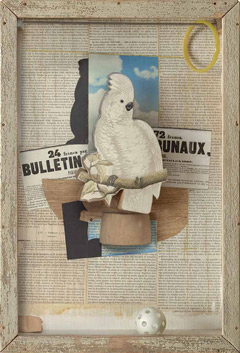Research : Joseph Cornell
- Lottie Matthews

- Mar 1, 2020
- 2 min read
By collecting and carefully juxtaposing found objects in small, glass-front boxes, American artist Joseph Cornell created visual poems in which surface, form, texture, and light play together. Using tangible found objects, Cornell made narrative boxes about things we cannot see: ideas, memories, fantasies, and dreams - transforming everyday materials into extraordinary universes. Cornell's signature art form is the shadow box. Infused with a dream-like aura, the shadow boxes invite the viewer into Cornell's own private, magical world. Alternately known as "memory boxes," the pieces evoked memories associated with the items contained within Surrealist assemblage works.
However, beyond the particular pieces of work, Cornell lived most of his life in relative physical isolation, caring for his mother and his disabled brother at home and rarely left New York confines. Despite this, themes of voyage, discovery and travel allowed his imagination to play within notions of movement and wonder, allowing "the box" to form the core metaphor of Joseph Cornell’s life. This idea plays with concepts of collecting an internal world of imagination into an exterior poetic form and allowing connect with elements of an individual that would usually not be aware within a narrative by using art as a tool to give form.
"Look at everything as though you are seeing it for the first time, with eyes of a child, fresh with wonder. Children understand and remember concepts best when they learn from direct personal experience. My boxes are life's experiences aesthetically expressed."
By looking at the art term that Cornell encapsulated, assemblage is art that is made by collecting disparate elements, however can also be defined by a gathering of things or people. These concepts however can drift beyond artistic terminology and further into social psychology and cultural theory. For example bricolage is the construction or creation of a work from a diverse range of things that happen to be available, or a work constructed using mixed media. Developed further my philosophers and theorists such as Claude Lévi-Strauss, theories surrounded how societies create novel solutions by using resources that already exist in the collective social consciousness. Psychological bricolage, therefore, refers to the cognitive processes that enable individuals to retrieve and recombine previously unrelated knowledge they already possess, building into concepts of creative cognition. Therefore, this relational between Cornell's own visual assemblage and ideas into forming meaning through a collection of objects and concepts can relate further into both personal imagination and greater reflections on community collectives and themes surrounding their creativity.
Further work includes :Timestamped (2019) and Postcards (2019) - a combined mixed media/found object continual collage installation assembling moments and parts of a narrative
















Comments